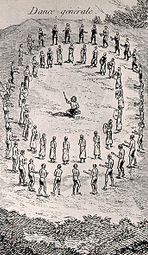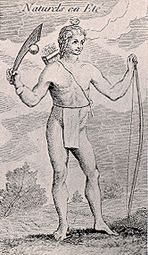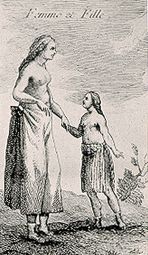The Natchez Indians
by George Sabo III
When La Salle descended the Mississippi at the end of the following century, the Natchez occupied a series of towns on the east bank of the river, in the vicinity of the modern town that today bears their name. They controlled a large territory that extended along both sides of the lower Mississippi River. The Natchez are famous in the anthropological literature on Southeastern Indians for their elaborate social and ceremonial system and for their use of platform mounds, both of which are key to their identity as the last example of the mound-building cultures that dominated the Mississippi Valley during late prehistoric times.
According to their origin story, the Natchez achieved their identity when a man and his wife joined a preexisting community. The newcomers were so bright that they appeared to have come from the sun. The man told the people about the Great Spirit and instructed them in the proper form of worship. He also gave them rules according to which they should live. These rules included instructions for building a temple on top of a platform mound where community leaders could communicate with the Great Spirit, who would be represented by an eternal fire within the temple. The community leader would be called the Great Sun. Natchez social organization was based on the relationship of community members to the Great Sun. In the 17th century, French explorers and colonists met this leader, who lived in a large house on the top of a platform mound at the site that is now preserved by the State of Mississippi as the Grand Village of the Natchez. The Great Sun enjoyed the status of a living god, and such was his esteem that he was carried about on a litter wherever he went. Across from the Great Sun's mound, on the opposite side of a large, open plaza, was the temple mound. The Great Sun's principle advisor, his mother who was called White Woman, lived in a house on top of another platform mound. These individuals along with the White Woman's other children formed the highest class in Natchez society known as the Suns. Below the Suns were the Nobles, followed by the Honored People. Stinkards were commoners who occupied the lowest class in society. However, since people were required to take spouses from a lower class, and since class membership was inherited from the mother in this matrilineal society, many children of lower class fathers were born into a higher class.
Like most other Southeastern Indians, the Natchez were agriculturalists who raised fields of corn, beans, squashes, and other crops including tobacco. Hunting and fishing activities were important, but perhaps as much for recreational purposes as for the subsistence returns these activities yielded. The Green Corn ceremony was the apex of their annual cycle of religious events and ceremonies. French settlement alongside the Natchez began peacefully, but by the 1720s increasing demands upon their lands and resources led to hostilities, which culminated in a devastating war with the French during which the Natchez suffered tremendous losses. Those who were not killed during the war sought refuge among the Chickasaws, Creeks, Catawbas, and Cherokees. The Natchez endured many difficulties throughout the following centuries, but today they maintain a distinct cultural identity. Bibliography Le Page du Pratz, Antoine Lorenz, Karl Swanton, John R. |
||||||
 |

|


